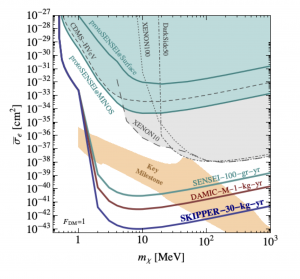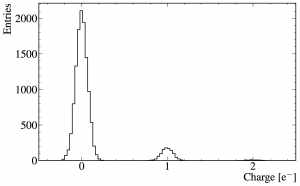Observatory of Skipper CCDs Unveiling Recoiling Atoms
The goal of this project is the development of a 10-kg skipper-CCD experiment for low mass dark matter search.

Sketch of the proposed 10 kg skipper-CCD experiment. Array of silicon detectors inside a vacuum vessel, cooled down with an LN2 system. The lead (grey) and polyethylene (white) shield suppress the environmental radiation from hitting the CCD.

Scientific reach for electron-recoil dark matter in the Oscura experiment accumulating 30-kg-yr exposure with Skipper-CCD technology. The forecast is compared with the planned SENSEI-100 and DAMIC-M experiments.

Demonstration of single-electron charge resolution in a skipper-CCD (4000 charge readout samples per pixel; bin width of 0.03 e-). The measured pixel charge is shown for pixels with low-light level. Integer electron peaks can be distinctly resolved. The peak at 0 e- has rms noise of 0.068 e-. The measurement demonstrate the single-electron sensitivity of the sensor.
Light Dark Matter
Identifying the nature of dark matter (DM) is one of the most important tasks of particle physics today, and direct-detection experiments play an essential role in this endeavor. The search for DM particles with masses a few orders of magnitude below the proton mass (“sub-GeV DM”) represents an important new experimental frontier. Improved sensitivity to DM masses well below the GeV scale is possible by searching for signals induced by inelastic processes, one of the most promising avenues is to search for one or a few ionized electrons that are released due to DM particles interacting with electrons in the detector. This is the main science goal for the Oscura experiment. The proposed effort brings together all the groups in the U.S. working on skipper-CCDs for the development of the ultimate DM experiment based on this technology.
Skipper-CCD as a tool for Dark Matter.
Among the most promising detector technologies for the construction of a large multi-kg experiment for probing electron recoils from sub-GeV DM are a new generation of silicon Charged Coupled Devices with an ultralow readout noise, so-called “skipper-CCDs”. Using these sensors pathfinder experiments (based on this technology are planned for the coming years. Specifically, SENSEI-100 plans to install a ~100 g detector at SNOLAB during 2020, while DAMIC-M plans to install a ~1 kg detector at Modane during 2023. Oscura plans to take the skipper-CCD scale the skipper-CCD to a 10 kg experiment. The Oscura effort brings together all the groups in the U.S. working on skipper-CCDs for the development of the ultimate DM experiment based on this technology.
To reach noise levels ≪ 1e−, skipper-CCDs measure the pixel charge by averaging over a large number of repetitive, uncorrelated CDS measurements. The charge is measured N times, and by taking the average of these measurements the white noise in the output on the CCD is reduced by 1/√N. The effect of low-frequency 1/f noise is drastically reduced, since the integration time of each measurement is much shorter than in the conventional readout
Institutions and points of contact
- Fermilab (contact J. Estrada)
- Lawrence Berkeley National Laboratory (contact S.Holland)
- Pacific Northwest National Laboratory (contact B. Loer)
- University of Washington (contact A. Chavarria)
- Stony Brook University (contact R. Essig)
- University of Chicago (contact P.Privitera)









